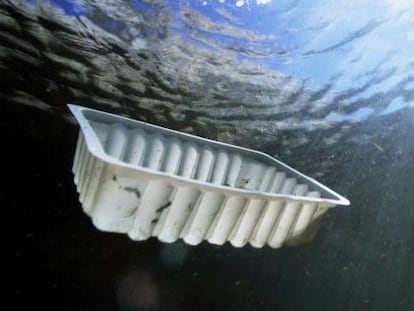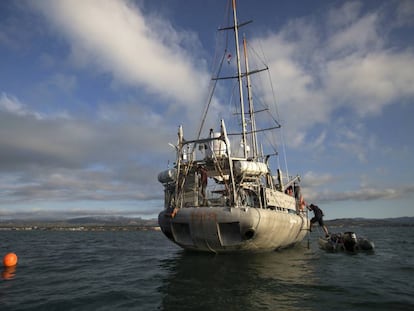Squid and sanitary wipes: a regular fishing day in the Mediterranean
Fishermen in the Barcelona region have to deal with particularly high levels of sea pollution, including plastics and trash from the 1970s

Early in the morning, the port of Barcelona is shrouded in darkness and the fishing vessel Bona Mar 2 smells of fried lamb¡¯s liver and onion. It is what Ousmane Tehior, 49, is preparing for breakfast. A seasoned sailor, he has been fishing since he was a child in Senegal.
On the bridge of the Bona Mar 2, Carlos Mart¨ªn, the boat¡¯s captain, shines a light on a piece of trash they have pulled from the sea ¨C the chassis of a Seat 750, which was on the market 60 years ago. Mart¨ªn also has a salvaged 1956 calendar in his house.
In one haul, the fishermen pick up plastic bottles, sanitary wipes and condom packets
The sea is awash with garbage, including stuff that was ditched centuries ago, such as the broken amphora that now decorates the Bona Mar 2. But most of the debris is not that special. In fact, it really is trash. The metropolitan area of Barcelona is the second-biggest culprit when it comes to emptying plastic waste into the Mediterranean, according to a 2019 report from the World Wildlife Fund, trumped only by ?ukurova in the southern coast of Turkey.
Researchers from the Institute of Marine Sciences (ICM-CSIC) concluded in another report that between Barcelona and Vilanova i la Geltr¨², trash accounts for 38% of a fisherman¡¯s catch. They also analyzed the amount of residue in the Ebro river delta and found that a mere 5% was litter. Moreover, Mart¨ªn and Llu¨ªs Tall¨®, the owner of Bona Mar 2, don¡¯t think that 38% is a particularly accurate figure; they would put it lower.
The Fishermen¡¯s Association of Barcelona, which comprises around a dozen boats, agreed in 2015 to take the trash they fished from the sea back to port. EL PA?S went aboard the Bona Mar 2 on September 20 and witnessed the vessel return to shore with 350 kilograms of fish and 20 kilograms of trash. This, in fact, was not all the debris that was caught in their nets, but the smaller pieces go back into the water along with the seaweed and sediment. ¡°Even after a heavy storm, we pick up 30 kilograms at the most, including everything that comes down the Bes¨°s and Llobregat rivers,¡± says Mart¨ªn. ¡°It¡¯s not even 10% of our catch.¡±
This problem can be solved with education
Carlos Mart¨ªn, captain of ¡®Bono Mar 2¡¯
Mart¨ªn¡¯s assessment coincides with other scientific data; namely that most of the litter is land-based ¨C 80% of it, according to the European Commission ¨C and that the rivers Llobregat and Bes¨°s are the main highways that carry it out to sea. The ICM-CSIC report insists it is affecting the fishing industry, reducing the catch and wasting fishermen¡¯s time as they are forced to clean and repair their nets.
Mart¨ªn, who has been trawling the ocean for the past 30 years, says that nowadays less trash comes out of the water, though in the past four years there has been a rash of disposal wipes made from cellulose. ¡°They are a headache,¡± he says. ¡°They get caught in the nets and it¡¯s really difficult to get them off.¡±
The nets are first emptied six miles off the coast of Sitges, after almost two hours of trawling. The maneuver is repeated three times over 12 hours: the first one produces the least trash, being at the furthest point from Barcelona, explains Mart¨ªn.
Aboard the Bona Mar 2, the nets¡¯ contents reveal a mass of mud, squid, fish, starfish and objects such as industrial sealing tape and disposable wipes in a tangle of seaweed. The second haul is done opposite Barcelona¡¯s El Prat airport, where the horizon is lined with merchant and cruise ships ¨C also a significant source of debris. This time, copious amounts of plastic bottles, sanitary napkins and condom packets nestle alongside the monkfish.
The metropolitan area of Barcelona is the second-biggest culprit when it comes to emptying plastic waste into the Mediterranean
Brands from the 1970s are fished out too, such as a Danone yogurt pot from 1977 and a small Lafich shampoo container with a price tag of six pesetas, the Spanish currency before the euro was adopted. There are also objects from cruise ships, such as a plastic ashtray with the Grimaldi Group logo and beauty products by a brand from Genoa.
When the nets are pulled up for the last time, between the the Llobregat and the Bes¨°s river deltas, debris from 90 meters down is dredged up. There are shoe soles, sunflower seed and potato chip bags, a beer can, a Mistol bottle of detergent from the 1970s, a Playmobil toy, more disposable wipes and a number of glass bottles. ¡°We can watch the evolution of brands from the boat,¡± says Jordi Tom¨¢s Hierro, Bona Mar 2¡¯s helmsman. ¡°We are seeing fewer and fewer bags from [former superstore] Pryca and Coca-Cola glass bottles. There was a load of them before.¡±
Mart¨ªn and Tall¨® insist that from where they are standing, there is evidence that trash is being more efficiently disposed of these days. ¡°People are increasingly aware,¡± says Mart¨ªn, recalling his childhood days when he had to cross a floating carpet of garbage before they could swim in the sea at Barceloneta beach. ¡°This problem can be solved with education.¡±
Microplastics and coal residue
Not all sea debris is easily identified. Scientists from Barcelona University detected an average of 100,000 microplastics ¨C less than 5mm in diameter ¨C per square kilometer along the Mediterranean coast. The report warns that plastic is ingested by marine life, including plankton, and that 65% of the microplastics that have been detected are composed of polyethylene.
Research from the Institute of Marine Sciences adds another hidden pollutant that makes up 28% of the trash along the Catalan coast: clinker, the residue from coal furnaces used to fuel ships during 150 years.
English version by Heather Galloway.
Tu suscripci¨®n se est¨¢ usando en otro dispositivo
?Quieres a?adir otro usuario a tu suscripci¨®n?
Si contin¨²as leyendo en este dispositivo, no se podr¨¢ leer en el otro.
FlechaTu suscripci¨®n se est¨¢ usando en otro dispositivo y solo puedes acceder a EL PA?S desde un dispositivo a la vez.
Si quieres compartir tu cuenta, cambia tu suscripci¨®n a la modalidad Premium, as¨ª podr¨¢s a?adir otro usuario. Cada uno acceder¨¢ con su propia cuenta de email, lo que os permitir¨¢ personalizar vuestra experiencia en EL PA?S.
?Tienes una suscripci¨®n de empresa? Accede aqu¨ª para contratar m¨¢s cuentas.
En el caso de no saber qui¨¦n est¨¢ usando tu cuenta, te recomendamos cambiar tu contrase?a aqu¨ª.
Si decides continuar compartiendo tu cuenta, este mensaje se mostrar¨¢ en tu dispositivo y en el de la otra persona que est¨¢ usando tu cuenta de forma indefinida, afectando a tu experiencia de lectura. Puedes consultar aqu¨ª los t¨¦rminos y condiciones de la suscripci¨®n digital.











































